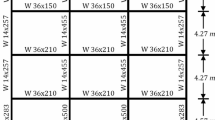Abstract
A tuned mass damper (TMD) is a device consisting of a mass, a spring, and a damper attached to a structure to reduce its dynamic response. The TMD concept was first applied at the beginning of the 20th century to reduce the rolling motion of ships and ship hull vibrations. Although currently they are mainly used to reduce wind-induced oscillations in buildings, there are also applications to reduce the response of the building under seismic action. Plastic deformations induced in the structural elements during strong earthquakes modify the dynamic characteristics of the structure, which makes the behaviour of the TMD system during seismic action more complex than in the case of wind, where the structure remains elastic. Often, the performance requirement that dictates the design of a building structure is the limitation of drifts induced by frequent earthquakes or by wind. Although the TMD may not be practical in reducing the structural response under larger earthquakes, it may represent a convenient solution for limiting non-structural damage under frequent earthquakes. To investigate this possibility, a steel moment resisting frame equipped with a sliding TMD system is designed and analysed using nonlinear response history analyses. The advantages, disadvantages, and effectiveness of TMD systems in reducing structural response in frequent and design-level earthquakes are investigated.
Access this chapter
Tax calculation will be finalised at checkout
Purchases are for personal use only
Similar content being viewed by others
References
Frahm H (1909) Device for damping vibration of bodies. US Patent, 989958
Ormondroyd J, Den Hartog JP (1928) The theory of the dynamic vibration absorber. Trans Am Soc Mech Eng 50:9–22
Kaynia AM, Veneziano D, Biggs JM (1981) Seismic effectiveness of tuned mass dampers. J Struct Div 107:1465–1484
Sladek JR, Klingner RE (1983) Effect of tuned-mass dampers on seismic response. J Struct Eng 109:2004–2009
Lin C, Hu C, Wang J, Hu R (1994) Vibration control effectiveness of passive tuned mass dampers. J Chin Inst Eng 17:367–376
Horiuchi H, Fujisawa N, Tsumura N (1991) Practical formulas for estimating design parameters of TMD. J Struct Eng Am Soc Civil Eng (ASCE) 37:781–788
Villaverde R (1985) Reduction seismic response with heavily-damped vibration absorbers. Earthq Eng Struct Dyn 13:33–42
Villaverde R (1994) Seismic control of structures with damped resonant appendages. In: Proceedings of 1st World Conference on Structural Control, Los Angeles, California, USA, pp WP4-113–119
Villaverde R, Koyama LA (1993) Damped resonant appendages to increase inherent damping in buildings. Earthq Eng Struct Dyn 22:491–507
Villaverde R, Martin SC (1995) Passive seismic control of cable-stayed bridges with damped resonant appendages. Earthq Eng Struct Dyn 24:233–246
Ruiz SE, Esteva L (1997) About the effectiveness of tuned mass dampers on nonlinear systems subjected to earthquakes. In: Earthquake resistant engineering structures, advances in earthquake engineering, pp 311–320
Sadek F, Mohraz B, Taylor AW, Chung RM (1997) A method of estimating the parameters of tuned mass dampers for seismic applications. Earthq Eng Struct Dyn 26:617–635
Miranda JC (2005) On tuned mass dampers for reducing the seismic response of structures. Earthq Eng Struct Dyn 34:847–865
Wong KKF, Chee YL (2004) Energy dissipation of tuned mass dampers during earthquake excitations. Struct Design Tall Spec Build 13:105–121
Wong KK (2008) Seismic energy dissipation of inelastic structures with tuned mass dampers. J Eng Mech 134:163–172
prEN 1998–1–2 (2021) Eurocode 8: Design of structures for earthquake resistance - Part 1–2: Rules for new buildings. European Committee for Standardization (CEN)
Author information
Authors and Affiliations
Corresponding author
Editor information
Editors and Affiliations
Rights and permissions
Copyright information
© 2022 The Author(s), under exclusive license to Springer Nature Switzerland AG
About this paper
Cite this paper
Voica, T.F., Stratan, A. (2022). Controlling Drift Demands in Steel Moment Resisting Frames at Frequent Earthquakes Using Tuned Mass Dampers. In: Mazzolani, F.M., Dubina, D., Stratan, A. (eds) Proceedings of the 10th International Conference on Behaviour of Steel Structures in Seismic Areas. STESSA 2022. Lecture Notes in Civil Engineering, vol 262. Springer, Cham. https://doi.org/10.1007/978-3-031-03811-2_79
Download citation
DOI: https://doi.org/10.1007/978-3-031-03811-2_79
Published:
Publisher Name: Springer, Cham
Print ISBN: 978-3-031-03810-5
Online ISBN: 978-3-031-03811-2
eBook Packages: EngineeringEngineering (R0)




